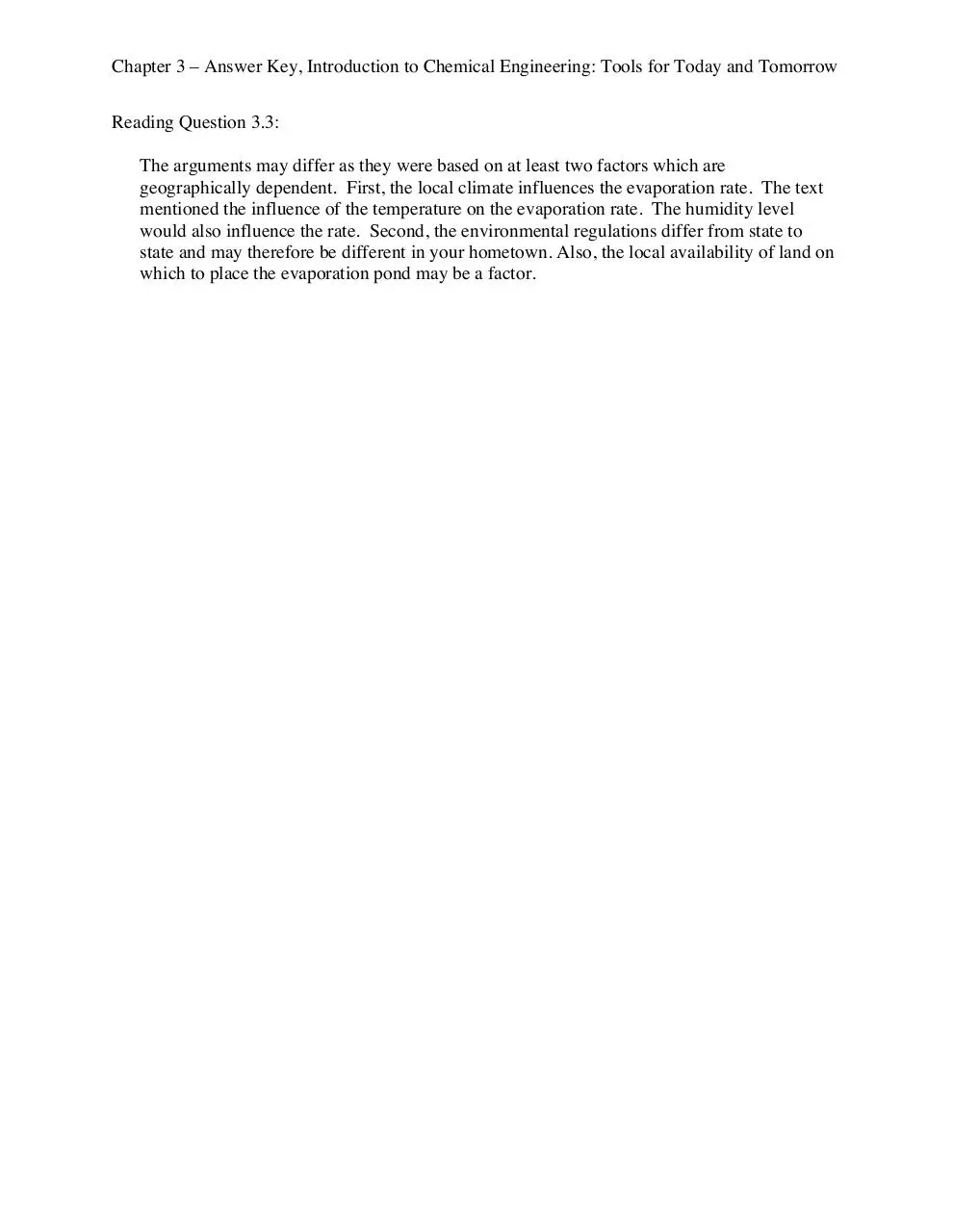introduction to chemical engineering ch (3) (PDF)
File information
Title: Chapter 3
Author: Ken Solen
This PDF 1.3 document has been generated by Microsoft Word / Mac OS X 10.6.4 Quartz PDFContext, and has been sent on pdf-archive.com on 21/02/2017 at 17:30, from IP address 47.197.x.x.
The current document download page has been viewed 2399 times.
File size: 48.58 KB (11 pages).
Privacy: public file





File preview
Chapter 3 – Answer Key, Introduction to Chemical Engineering: Tools for Today and Tomorrow
Reading Question 3.1:
a) List possible solutions
Develop a plan
b) Evaluate and rank the possible solutions
Re-evaluate the plan to check desirability
Check the result
Chapter 3 – Answer Key, Introduction to Chemical Engineering: Tools for Today and Tomorrow
Reading Question 3.2:
An independent company would have to treat and dispose of the acid just as our company
would have to do. In addition, transportation costs and profit for that company would be
added onto the charge we would have to pay. Thus, it would seem that we can do it more
cheaply. This would not be true, however, if the independent company already had
equipment for doing the necessary treatment. For this analysis, we assumed that no such
company could be identified.
Chapter 3 – Answer Key, Introduction to Chemical Engineering: Tools for Today and Tomorrow
Reading Question 3.3:
The arguments may differ as they were based on at least two factors which are
geographically dependent. First, the local climate influences the evaporation rate. The text
mentioned the influence of the temperature on the evaporation rate. The humidity level
would also influence the rate. Second, the environmental regulations differ from state to
state and may therefore be different in your hometown. Also, the local availability of land on
which to place the evaporation pond may be a factor.
Chapter 3 – Answer Key, Introduction to Chemical Engineering: Tools for Today and Tomorrow
Reading Question 3.4:
The two properties that would need to be changed are the pH and temperature of the waste
stream.
Chapter 3 – Answer Key, Introduction to Chemical Engineering: Tools for Today and Tomorrow
Reading Question 3.5:
If our waste stream exceeded the maximum limit of dissolved solids, we would have to
consider means of reducing the concentration of dissolved solids in order to satisfy the
regulations.
Chapter 3 – Answer Key, Introduction to Chemical Engineering: Tools for Today and Tomorrow
Reading Question 3.6:
The key assumption behind the use of teams is that the team as a whole can accomplish more
than the sum of the efforts of the individuals working alone. This assumption will not be true
if the group does not function well because of poor communication, lack of cooperation, etc.
Chapter 3 – Answer Key, Introduction to Chemical Engineering: Tools for Today and Tomorrow
Reading Question 3.7:
Answers will vary from student to student. Your response, however, should reflect an
understanding of the role that you have chosen.
Chapter 3 – Answer Key, Introduction to Chemical Engineering: Tools for Today and Tomorrow
Reading Question 3.8:
Knowledge of the stages of team development can help the team proceed more rapidly to
the performing stage. It is important to understand, for example, that conflict is normal and
can be overcome in order to achieve the desired outcomes.
Chapter 3 – Answer Key, Introduction to Chemical Engineering: Tools for Today and Tomorrow
Homework Problem 3.2:
This should simply include items (a) through (f) as stated in the problem. Example:
From: Douglas E. Law, Engineer, Chemical Process Group
To:
Barbara Magelby, Supervisor, Chemical Process Group
This is to confirm that I have received your memo concerning our hydrochloric acid
waste disposal problem. My team has met and begun deliberations on this matter.
Thus far, we have considered several possibilities with regard to managing our waste
product. The following ideas have the most merit:
1. Contract with an outside company to dispose of the waste for us. While this
option is attractive because it requires very few other changes, it leaves us
vulnerable to future instabilities in other companies as is the present case.
2. Treat the waste ourselves and dispose the final stream in the lake on the adjacent
property. This would require a process similar to that used by the companies with
which we might contract, but we would be spared the costs of transportation and
profits required by such companies. Significant initial investment would be
required for equipment and construction, but is likely to result in long-term
savings, if not profits.
After consideration of these and other possibilities, my team has concluded that treating
the waste ourselves is the most attractive option at this time. We are currently
formulating a preliminary design and will continue to keep you informed of our progress.
Download introduction to chemical engineering ch (3)
introduction to chemical engineering ch (3).pdf (PDF, 48.58 KB)
Download PDF
Share this file on social networks
Link to this page
Permanent link
Use the permanent link to the download page to share your document on Facebook, Twitter, LinkedIn, or directly with a contact by e-Mail, Messenger, Whatsapp, Line..
Short link
Use the short link to share your document on Twitter or by text message (SMS)
HTML Code
Copy the following HTML code to share your document on a Website or Blog
QR Code to this page

This file has been shared publicly by a user of PDF Archive.
Document ID: 0000558103.